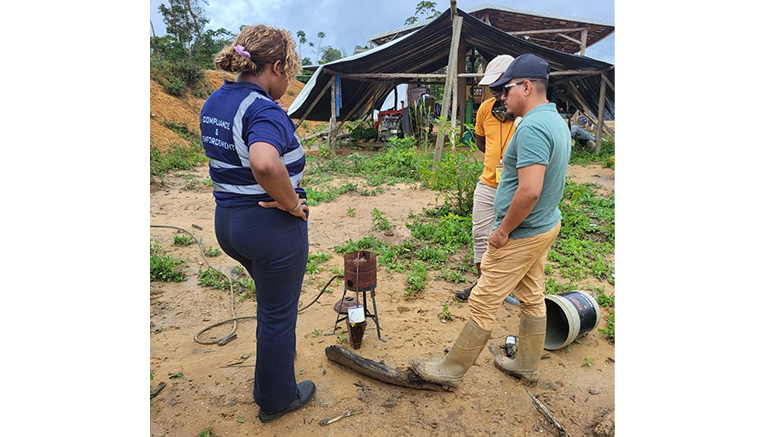The EPA’s Green Walk rallies hundreds while reinforcing community action and environmental awareness across Guyana
TODAY, hundreds of people joined what the Environmental Protection Agency (EPA) of Guyana is calling the biggest walk for the environment. Dubbed The Green Walk, the event is part of the EPA’s annual celebrations for World Environment Day and its 29th anniversary.
This year, the walk is being held under the national theme of “Ending Plastic Pollution,” with a goal of drawing attention to the growing problem of plastic waste in Guyana and the wider world. But for the EPA, the walk is just one piece of a larger puzzle. From community outreach and school-based education to active projects addressing waste management, the agency is pushing to build a more environmentally conscious society—one that sees plastic pollution not just as a nuisance but as a serious environmental issue.

To better understand the significance of World Environment Day and the EPA’s role in addressing plastic, the Pepperpot Magazine spoke with Ladonna Kissoon, an Environmental Officer at the agency for more than a decade. She shared that the Green Walk, although an international event, has become the signature event of the agency, coinciding with the EPA’s anniversary this year. The topic of plastic is also particularly important to Guyana. In a country known for its rich natural diversity, plastic pollution can threaten its untouched, pristine biodiversity.
Highlighting the prevalence of plastic pollution, Ladonna pointed out that it is not just an environmental problem, but also presents legal challenges. “I think this is not just an environmental problem, but it’s also a legal problem that we are dealing with—the issue of plastic pollution. And I say the issue of plastic pollution, not the issue of plastics because that’s what we really need to take into consideration. Plastic is not the issue; the pollution aspect is. And I feel we really need to refocus our energies with regards to that aspect. You know, just looking at it from the perspective of how we dispose and discard our plastics or waste, and really rethinking our approach to plastics itself,” she stated.
So, what exactly is the cause of plastic pollution? The answer may seem simple: plastic. But more than the presence of plastic is the way it is disposed of. Plastic-based materials are found in everyday items, from water bottles and bags to office materials and phone cases. Although we may not be able to completely remove them from our lives, it is how these plastics are disposed of, rather than recycled, that makes all the difference. “Oftentimes, we collect plastics that we don’t necessarily need to collect. So, at this point, what we’re asking persons to do, or the charge we’re giving persons this year, is to rethink their use of plastics. And in rethinking it, they will be able to refuse plastics, especially plastics that they’re not going to use. By refusing the plastics, we’ll be able to reduce the amount of plastics that we have in the environment,” Ladonna stated.
The EPA isn’t just making the call for individuals to do better. They are actively working with communities across Guyana to manage waste more effectively. From garbage collection to proper waste storage, these efforts aim to prevent environmental hazards caused by indiscriminate dumping. Highlighting a few of these initiatives, Ladonna stated, “We have a number of projects that we are presently working on that look at waste management in each facility, not just plastic waste. So we have a number of projects that we are working on, projects with communities that include garbage collection, finding a proper space to store the garbage or store the waste so that it’s not scattered around the community or people dispose of it in a manner which is not environmentally safe.”
One of the most significant contributors to ending plastic pollution is the community. This is why the EPA has been actively engaging communities all across Guyana in an attempt to drive home the message that pollution is everybody’s business. “We have been engaging communities. We are presently looking at the Grove community.” She further added, “We take to the streets of Guyana and take it to the communities where we just remind persons of their responsibility to ensure that where they are, and the space they’re in is kept in an environmentally safe manner. Not just benefitting the environment, but also benefitting themselves.”
These community outreaches have been making a difference, with more people engaging and recognising the importance of being earth-conscious. “We want them to know that what they’re doing or what somebody else is doing is not good for the environment so that they could inform us and then we can take action against that. So I do believe our presence or initiatives are definitely making an impact,” she shared.
Today, the EPA hopes that the Green Walk will do more than remind people about the impact of pollution—they hope it will inspire them to take action. “This year for our Green Walk, the walk is really to put our voices together as of taking a stand against plastic pollution.” As simple as it may seem, the Green Walk sends a powerful message: environmental change begins with awareness, but it requires continued action, both from individuals and the systems that serve them. From community projects to education campaigns, the EPA is working steadily to inspire a new generation of earth-conscious citizens. The message is clear: reduce, refuse, and rethink how we use plastic. So, if you are looking for something to do today, feel free to head out to the National Park, where the Green Walk is slated to include a ceremony. Because saving the planet starts not only with a walk, but with every step we take afterwards.



.jpg)








